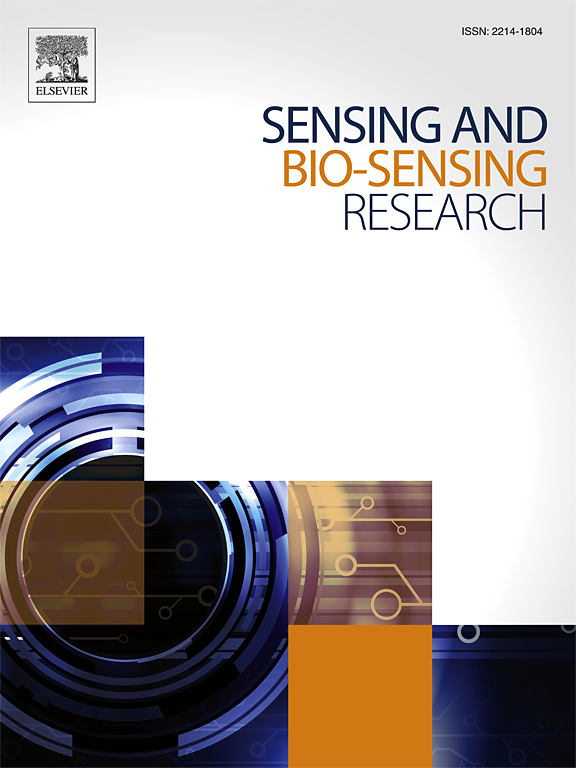微流体pH传感的小型化多光谱成像
IF 4.9
Q1 CHEMISTRY, ANALYTICAL
引用次数: 0
摘要
基于互补金属氧化物半导体(CMOS)的多光谱芯片实验室成像是一项创新技术,支持便携式微流体平台,能够从多个波长下的样品中提取光谱信息。准确的pH值传感在各种化学,生物,医学和环境应用中是必不可少的。在本文中,我们提出了一种利用基于cmos的多光谱片上实验室成像进行pH传感的新方法。利用横跨可见光和近红外光谱的六波段彩色滤光片阵列和u型PDMS微流控通道,单色CMOS图像传感器捕获特定pH值溶液的图像。为了预测pH值,我们开发了一个支持向量回归(SVR)模型,该模型使用捕获的六个波段的图像进行训练。该模型预测pH值的RMSE为0.364。我们的研究表明,多光谱芯片实验室成像是一种小型、快速、高灵敏度、高精度的pH传感方法。本文章由计算机程序翻译,如有差异,请以英文原文为准。
Miniaturized multispectral imaging for microfluidic pH sensing
Multispectral lab-on-chip imaging based on complementary metal-oxide semiconductor (CMOS) is an innovative technology that supports portable microfluidic platforms and enables the extraction of spectral information from specimens under multiple wavelengths. Accurate pH sensing is essential across a diverse range of chemical, biological, medical, and environmental applications. In this paper, we presented a new approach for pH sensing using the CMOS-based multispectral lab-on-chip imaging. Using a six-band color filter array that spans the optical spectrum in the visible and near-infrared range and a U-shape PDMS microfluidic channel, images of solutions with specific pH values were captured by a monochrome CMOS image sensor. To predict pH values, we developed a Support Vector Regression (SVR) model, which was trained using captured images of the six bands. Predicted pH values were obtained by the model with an RMSE of 0.364. Our research demonstrates that multispectral lab-on-chip imaging represents a miniature and rapid method to achieve pH sensing with high sensitivity and accuracy.
求助全文
通过发布文献求助,成功后即可免费获取论文全文。
去求助
来源期刊

Sensing and Bio-Sensing Research
Engineering-Electrical and Electronic Engineering
CiteScore
10.70
自引率
3.80%
发文量
68
审稿时长
87 days
期刊介绍:
Sensing and Bio-Sensing Research is an open access journal dedicated to the research, design, development, and application of bio-sensing and sensing technologies. The editors will accept research papers, reviews, field trials, and validation studies that are of significant relevance. These submissions should describe new concepts, enhance understanding of the field, or offer insights into the practical application, manufacturing, and commercialization of bio-sensing and sensing technologies.
The journal covers a wide range of topics, including sensing principles and mechanisms, new materials development for transducers and recognition components, fabrication technology, and various types of sensors such as optical, electrochemical, mass-sensitive, gas, biosensors, and more. It also includes environmental, process control, and biomedical applications, signal processing, chemometrics, optoelectronic, mechanical, thermal, and magnetic sensors, as well as interface electronics. Additionally, it covers sensor systems and applications, µTAS (Micro Total Analysis Systems), development of solid-state devices for transducing physical signals, and analytical devices incorporating biological materials.
 求助内容:
求助内容: 应助结果提醒方式:
应助结果提醒方式:


